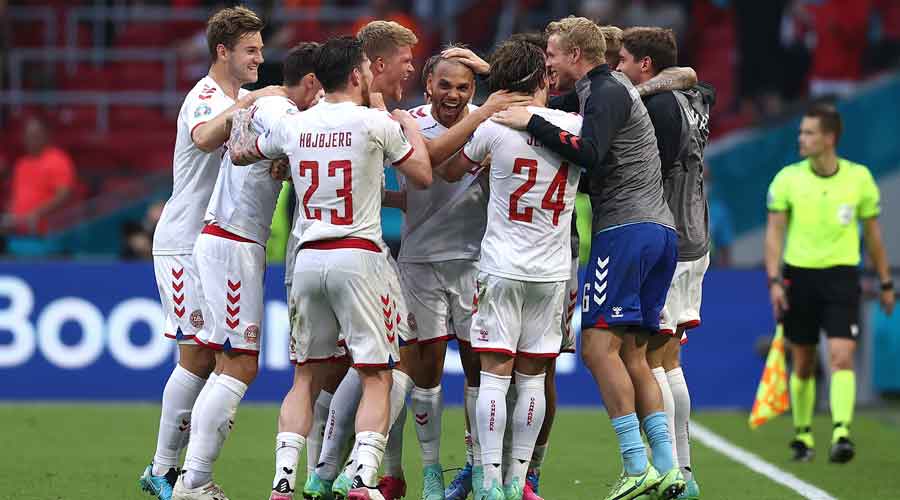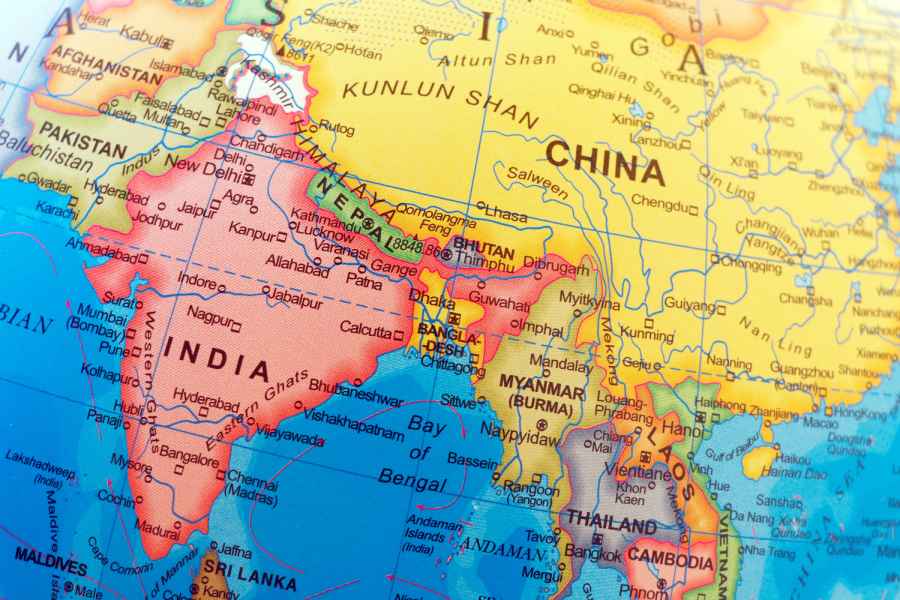Jan Laursen was inside the Parken Stadium in Copenhagen on the afternoon Denmark lost to Belgium. The result, at the time, felt secondary. For most in the crowd, the game was a chance to show their affection not only for the absent Christian Eriksen, but for a team that had acted with such grace and courage even in the thick of primal horror.
The abiding feeling inside the stadium that day, to Laursen, was one of intense pride: in Eriksen, in the conduct of his teammates, and in the way that Denmark approached the game.
In the circumstances, expectations were not so much low as irrelevant. Belgium would later be eliminated from Euro 2020 by Italy but at the time it was, officially, the best team in the world. Denmark, by contrast, had other things on its mind.
And yet, from the moment they took to the field, the Danish players tore at their opponents. “Even though we lost, you could see the team was always trying to attack,” Laursen said. “They did not do the safe and secure thing. They took risks for what they believed in.”
Laursen has more reason to feel proud than most. He has spent the past 20 years working for FC Nordsjaelland, a team based in the town of Farum, 30 minutes or so north of Copenhagen. He started as a player, spent a decade and a half as sporting director, and now, at 50, serves as the team’s chairman.
No club can claim to have shaped the current iteration of the Danish national team quite so much as Nordsjaelland, and no executive to have exerted quite so much influence.
Laursen pursued Kasper Hjulmand for three years before hiring him; Hjulmand is now the national team’s coach. Hjulmand’s assistant with Denmark, Morten Wieghorst, worked at Nordsjaelland, too. Christian Norkjaer, Denmark’s team manager — a sort of administrative and strategic position — was Laursen’s right-hand man for six years.
It does not stop there. Two members of Hjulmand’s squad at Euro 2020, Jens Stryger Larsen and Anders Christiansen, spent time at the club. More significant, three other Denmark players graduated from its academy: Mathias Jensen, Andreas Skov Olsen and the country’s breakout star, Mikkel Damsgaard.
Laursen would be forgiven, then, for feeling that Nordsjaelland is owed at least a shred of the credit for Denmark’s success this summer: Its 2-1 victory against the Czech Republic on Saturday sent the country to the semifinal of a major tournament for the first time since 1992.
“I think of it like Noma, the restaurant,” he said. “At first, nobody thought foraging their own food would work. But it did what it believed in, and after a while, people started to appreciate it.”
Soccer finds this sort of reverse-engineered explanation compelling, bordering on irresistible. It takes what appears, at first, to be an unsettlingly opaque sort of success — an unheralded team suddenly coalescing and crystallizing into something formidable — and transforms it into a story, one with a beginning, a middle and an end, one with an inner logical structure.
The appeal is obvious: It means there is a recipe that can be followed, a method that can be packaged, a result that can be replicated. All you need is a team to institute the same sort of principles as Nordsjaelland — a focus on and a belief in youth; an emphasis on style as a vector for victory; an international outlook, as manifested in the collaboration with Right to Dream, an academy with its roots in Ghana that bought the club six years ago — and, in time, your national team, too, will find itself two games away from continental glory.
Laursen knows that is magical thinking. While he sees Denmark’s renaissance as vindication for Nordsjaelland’s work — the club, he said, thinks of itself as a “university,” the best place for teenagers to complete their education so that they are ready to go out into the world, an account that Damsgaard, now with the Italian club Sampdoria, has endorsed — he does not pretend that it has changed Danish soccer.
Nordsjaelland, he said, is still an outlier: younger than most of its opponents, with a less “tactical, physical” style, less likely to place considerable emphasis on set pieces. His hope is that its role in Denmark’s success can lead to a “breakthrough in the Danish consciousness.” But he knows that Nordsjaelland could not be a beneficiary if it was also the cause.
The reality is far messier, far more complex. There is no one single factor behind Denmark’s rise, no order than can be easily retrofitted.
To some extent, the dice have fallen in its favor. Denmark’s group in Euro 2020 was a kind one: It could qualify, in second place, having won only one game. That granted Hjulmand’s team a meeting with Wales in the round of 16. And the Czech Republic did not prove to be the most daunting quarterfinal opponent it might have faced.
Even the timing of the tournament itself has proved beneficial. Had the tournament taken place, as scheduled, last summer, Hjulmand would not have been in charge — his predecessor, the Norwegian Age Hareide, was still under contract. That version of Denmark was a little more stolid, a little more perfunctory, not yet influenced by what Laursen calls the “brilliant football brain” of its current coach.
The squad, too, might have looked very different. The delay did not just allow Hjulmand to blend his attacking impulses with the defensive surety instilled by Hareide, but it also allowed a cluster of young players, led by Damsgaard, to come of age in time to call a previous generation teammates, rather than predecessors — Eriksen, for example, and captain Simon Kjaer.
If the timing is fortuitous, the promise of those young players is not. “There was a big investment in talent education in Denmark a few years ago,” said Soren Berg, the head of analysis at FC Midtjylland, another of the country’s leading clubs. “We have done well at under-21 level for a long time. The first age group to benefit were born in 1994 and 1995. They are now the core of the senior national squad.”
Those who came through at Nordsjaelland were exposed to an education designed to teach them “responsibility”: Laursen said the club would not think twice about playing a teenager if he were deemed good enough. “There are some things that you only learn when you play,” Laursen said. “You do not learn them from sitting on the bench and watching other people.”
While Nordsjaelland considers itself the standard-bearer for youth development in Denmark, that attitude is not, perhaps, unique. “Independent thinking is a big thing in Danish culture,” said Rasmus Ankersen, Midtjylland’s chairman. “The fact there is a lot of personality, a lot of leaders, in the team is not by chance.”
At first glance, Nordsjaelland and Midtjylland are two sides of the same coin: relatively young provincial teams that have emerged, over the past decade, to overturn the long-standing hegemony of the country’s traditional giants, Brondby and FC Copenhagen. What is significant about them, though, is that their rises have been propelled by very different ideas.
Where Nordsjaelland has placed its emphasis on youth, Midtjylland has sought to find an edge through its use of data and analytics. Nordsjaelland plays a soccer influenced by Hjulmand’s idols, Pep Guardiola and Johan Cruyff, while Midtjylland is, in Ankersen’s words, more traditionally Danish: intense, high-pressing, effective at set pieces.
These are all, though, surface differences; at heart, both teams are driven by a desire to innovate. That has had an immediate impact on the Superliga, Denmark’s top division, which in Laursen’s eyes is now an “extremely competitive” environment.
“It may not be a top-five league in Europe, and it might be outside the top 10, but I think a lot of people are surprised by how good it is,” Laursen said. (In one analysis of the relative strengths of Europe’s domestic competitions by a leading Premier League team, Denmark placed not far below the Netherlands in terms of quality.)
That has been a boon for Hjulmand, and for the national team. The coach has been able not only to borrow ideas from his alma mater, Nordsjaelland, but to pick the brains of the staff at Midtjylland, too. “There is no formal link,” said Berg, the Midtjylland data analysis executive. “But it is a small country. Everyone knows everyone else. We met with him a few months ago, and talked to him about the work we are doing.”
The increased competition has helped his players, too. Major European teams are more likely to recruit from leagues they deem to offer a good test of a player’s ability; Denmark is now a prime market. Only four members of Hjulmand’s squad still play on home soil — the vast majority play, and play regularly, in one of Europe’s top five leagues.
That combination of luck and effort and ideas and circumstance is not, perhaps, the sort of straightforward explanation that soccer cherishes, the one that makes any and all success feel natural, logical, somehow written in the stars. But it is fitting. What has brought Denmark to the quarterfinals is not one thing, one team, but a combination of them, the complex interplay between them. And, in the end, that might even be better: This way, the pride does not belong to one person, or one club, but to everyone.
New York Times News Service











